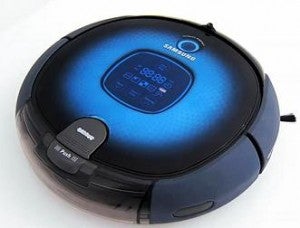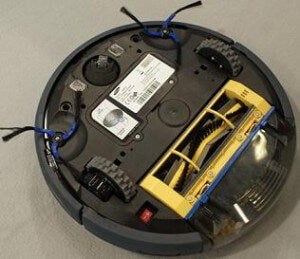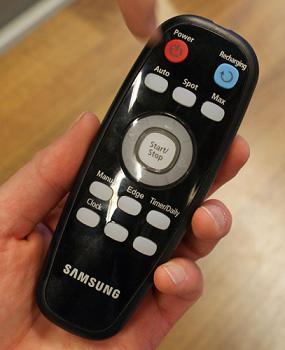
Samsung’s newest robot vacuum, the Navibot, looks and acts like an improved Roomba. It sports the same round shape but has special whip-like brushes to throw dirt into the path of its vacuum. Navibot’s best innovation over the Roomba, however, is it’s “Visionary Mapping System”. According to the AP, Navibot uses an upwards facing camera to capture images of the ceiling at 30 frames per second. Along with 30+ IR sensors around its periphery, Navibot uses the camera video to map out the room and plan an efficient path for cleaning. The vacuum will even return to its charging station if it’s running low on power. Other features include a drop-sensor so it won’t fall down stairs, a remote control which can vary vacuuming modes, and optional IR fences (Virtual Guards) that can seal off a room into sections. All these capabilities may put Navibot ahead of the Roomba, but it’s still a ways behind Neato’s XV-11. Samsung is launching the Navibot in Europe this year (UK in April) for €399 with one Virtual Guard or €499 with a touchscreen and two Virtual Guards. Check out the promo video from Samsung Europe below.
Nearly all of Navibot’s features are done better by the Neato XV-11. The VMS system is cool, but I think the XV-11’s SLAM and laser range finder do it better. Samsung chose to keep the round shape, even though Neato’s half moon design allows for better vacuuming at edges – those whip-like brushes may look cool, but they aren’t going to suck dirt out of thick carpeting. Both vacuums have an easy to use screen on top, drop sensors, and can return to base in case of power problems (though no word if Navibot will return to work after it recharges). The Neato only costs $399, however, about $150 less than the Navibot.

The only clear advantages Navibot has are in its accessories. Samsung’s choice to include a remote is clutch (sometimes you really don’t want to chase a robot down the hall), and the variable power settings are a great idea. The Virtual Guards, while a little big, let you avoid laying down long strips of magnetic tape. I bet with a little creativity you could hide them behind furniture and leave them installed permanently without messing up your feng shui. Neato, if you’re reading this, think about adding in a remote, variable power settings, and some IR fences – these are all good ideas.

Who wins in the robot vacuum wars (my money’s on Neato, clearly) probably isn’t as important as the fact that we are having a robot vacuum war. It’s great for consumers. The more competition out there, the better the innovations we’ll see and the lower prices will fall. Importantly, robot vacuums take only a small share of the total vacuum market (~2%). More competition will probably also mean more sales, helping that share grow. That’s good for iRobot, Samsung, Neato and other manufacturers. And it might just help bring home appliances into the 21st century by encouraging more to adopt robot features. Sure we have robotic dishwashers, clothes dryers, and vacuums, but where are the robot ovens and stoves? The robot lawn mowers? The robot cars? C’mon bots, clean my house! I’ve got places to be.
[image credits: Trusted Reviews]
[screen capture and video credit: Samsung]
[sources: Samsung, Associated Press]


